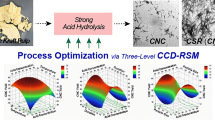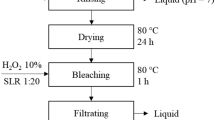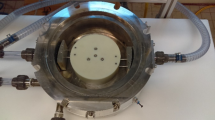Abstract
Nanocellulose has great potential for end use in the pulp and paper industry, but its mechanical production process is often extremely energy intensive. Although various pre-treatment methods have been introduced to significantly lower the energy consumption of nanocellulose production, there still remains a great challenge to match the cost to mechanical strength performance of nanocellulose. This research investigates the relationship between energy consumption with numerous refining and homogenization cycles towards the production of high aspect ratio and low diameter nanocellulose, and whether this is necessary to achieve high strength sheets. Never-dried Bleached Eucalyptus Kraft pulp was mechanically treated with a PFI mill refiner and homogenizer. The actual homogenization energy measured on a lab scale was significantly higher than that predicted only from the simplified pressure drop equation which is inaccurately independent of homogenizer design and size. We measured two aspects of fiber quality believed to be related to sheet mechanical strength: the fiber diameter, which is inversely proportional to the surface area available for bonding, and the fiber aspect ratio, which is believed to control the efficiency of stress transfer within a network. Both refining and homogenization reduced the fiber diameter and increased the aspect ratio, but homogenization was more effective at both. There was surprisingly little correlation between the measures of fiber quality and mechanical sheet strength. All PFI mill refined samples had a tensile index of around 100 Nm/g, while additional treatment with homogenization increased this only by approximately 20%. This was despite the most heavily treated fibers (50,000 PFI revolutions and 3 homogenization passes at 1000 bar) having a median diameter of 12 nm and aspect ratio of 229 compared to the least treated fibers (10,000 PFI revolutions) with a median diameter of 31 nm and aspect ratio of 102. The most heavily treated fibers required 39,000 kWh/t of energy, a tenfold increase over the least heavily treated fibers. The results confirmed that there was small benefit, in terms of mechanical strength, of using very large amounts of energy to produce very low diameter, high aspect ratio nanocellulose fibers.
Graphical abstract











Similar content being viewed by others
References
Alemdar A, Sain M (2008) Isolation and characterization of nanofibers from agricultural residues—wheat straw and soy hulls. Biores Technol 99:1664–1671. https://doi.org/10.1016/j.biortech.2007.04.029
Andresen M, Stenius P (2007) Water-in-oil emulsions stabilized by hydrophobized microfibrillated cellulose. J Dispers Sci Technol 28:837–844. https://doi.org/10.1080/01932690701341827
Ankerfors M (2012) Microfibrillated cellulose energy-efficient preparation techniques and key properties. KTH Royal Institute of Technology, Stockholm
Aulin C, Gällstedt M, Lindström T (2010) Oxygen and oil barrier properties of microfibrillated cellulose films and coatings. Cellulose 17:559–574. https://doi.org/10.1007/s10570-009-9393-y
Campano C et al (2018) Mechanical and chemical dispersion of nanocelluloses to improve their reinforcing effect on recycled paper. Cellulose 25:269–280. https://doi.org/10.1007/s10570-017-1552-y
Celzard A, Fierro V, Kerekes R (2009) Flocculation of cellulose fibres: new comparison of crowding factor with percolation and effective-medium theories. Cellulose 16:983–987. https://doi.org/10.1007/s10570-009-9314-0
Chang CP, Wang IC, Perng YS (2013) Enhanced thermal behavior, mechanical properties and UV shielding of polylactic acid (PLA) Composites reinforced with nanocrystalline cellulose and filled with nanosericite. Cellul Chem Technol 47:111–123
Dimic-Misic K, Gane PAC, Paltakari J (2013) Micro and nanofibrillated cellulose as a rheology modifier additive in CMC-containing pigment-coating formulations. Ind Eng Chem Res 52:16066–16083. https://doi.org/10.1021/ie4028878
Dimic-Misic K, Ridgway C, Maloney T, Paltakari J, Gane P (2014) Influence on pore structure of micro/nanofibrillar cellulose in pigmented coating formulations. Transp Porous Media 103:155–179. https://doi.org/10.1007/s11242-014-0293-8
Dimic-Misic K, Rantanen J, Maloney TC, Gane PAC (2016) Gel structure phase behavior in micro nanofibrillated cellulose containing in situ precipitated calcium carbonate. J Appl Polym Sci. https://doi.org/10.1002/app.43486
Dimic-Misic K, Maloney T, Gane P (2018a) Effect of fibril length, aspect ratio and surface charge on ultralow shear-induced structuring in micro and nanofibrillated cellulose aqueous suspensions. Cellulose 25:117–136. https://doi.org/10.1007/s10570-017-1584-3
Dimic-Misic K, Vanhatalo K, Dahl O, Gane P (2018b) Rheological properties comparison of aqueous dispersed nanocellulose derived from a novel pathway-produced microcrystalline cellulose or by conventional methods. Appl Rheol. https://doi.org/10.3933/applrheol-28-64474
Eichhorn SJ et al (2001) Current international research into cellulosic fibres and composites. J Mater Sci 36:2107–2131. https://doi.org/10.1023/A:1017512029696
Eichhorn SJ et al (2010) Review: Current international research into cellulose nanofibres and nanocomposites. J Mater Sci 45:1–33. https://doi.org/10.1007/s10853-009-3874-0
El Baradai O, Beneventi D, Alloin F, Bongiovanni R, Bruas-Reverdy N, Bultel Y, Chaussy D (2016) Microfibrillated cellulose based ink for eco-sustainable screen printed flexible electrodes in lithium ion batteries. J Mater Sci Technol 32:566–572. https://doi.org/10.1016/j.jmst.2016.02.010
Eriksen Ø, Syverud K, Gregersen Ø (2008) The use of microfibrillated cellulose produced from kraft pulp as strength enhancer in TMP paper. Nord Pulp Pap Res J 23:299–304
Ferrer A, Filpponen I, Rodríguez A, Laine J, Rojas OJ (2012) Valorization of residual empty palm fruit bunch fibers (EPFBF) by microfluidization: production of nanofibrillated cellulose and EPFBF nanopaper. Bioresour Technol 125:249–255. https://doi.org/10.1016/j.biortech.2012.08.108
Henriksson M, Henriksson G, Berglund LA, Lindström T (2007) An environmentally friendly method for enzyme-assisted preparation of microfibrillated cellulose (MFC) nanofibers. Eur Polym J 43:3434–3441. https://doi.org/10.1016/j.eurpolymj.2007.05.038
Henriksson M, Berglund LA, Isaksson P, Lindström T, Nishino T (2008) Cellulose nanopaper structures of high toughness. Biomacromolecules 9:1579–1585. https://doi.org/10.1021/bm800038n
Hubbe MA, Tayeb P, Joyce M, Tyagi P, Kehoe M, Dimic-Misic K, Pal L (2017) Rheology of nanocellulose-rich aqueous suspensions: a review. BioResources 12:9556–9661. https://doi.org/10.15376/biores.12.4.Hubbe
Isogai A, Saito T, Fukuzumi H (2011a) TEMPO-oxidized cellulose nanofibers. Nanoscale 3:71–85. https://doi.org/10.1039/c0nr00583e
Isogai T, Saito T, Isogai A (2011b) Wood cellulose nanofibrils prepared by TEMPO electro-mediated oxidation. Cellulose 18:421–431. https://doi.org/10.1007/s10570-010-9484-9
Iwamoto S, Nakagaito AN, Yano H, Nogi M (2005) Optically transparent composites reinforced with plant fiber-based nanofibers. Appl Phys A Mater Sci Process 81:1109–1112. https://doi.org/10.1007/s00339-005-3316-z
Iwamoto S, Nakagaito AN, Yano H (2007) Nano-fibrillation of pulp fibers for the processing of transparent nanocomposites. Appl Phys A Mater Sci Process 89:461–466. https://doi.org/10.1007/s00339-007-4175-6
Iwamoto S, Abe K, Yano H (2008) The effect of hemicelluloses on wood pulp nanofibrillation and nanofiber network characteristics. Biomacromol 9:1022–1026. https://doi.org/10.1021/bm701157n
Karande VS, Bharimalla AK, Hadge GB, Mhaske ST, Vigneshwaran N (2011) Nanofibrillation of cotton fibers by disc refiner and its characterization. Fibers Polym 12:399–404. https://doi.org/10.1007/s12221-011-0399-3
Karande VS, Mhaske ST, Bharimalla AK, Hadge GB, Vigneshwaran N (2013) Evaluation of two-stage process (refining and homogenization) for nanofibrillation of cotton fibers. Polym Eng Sci 53:1590–1597. https://doi.org/10.1002/pen.23413
Kerekes RJ (2005) Characterizing refining action in PFI mills. Tappi J 4:9–14
Kerekes RJ (2015) Perspectives on high and low consistency refining in mechanical pulping. BioResources. https://doi.org/10.15376/biores.10.4.8795-8811
Klemm D, Kramer F, Moritz S, Lindström T, Ankerfors M, Gray D, Dorris A (2011) Nanocelluloses: a new family of nature-based materials. Angew Chem Int Ed 50:5438–5466. https://doi.org/10.1002/anie.201001273
Kumar V et al (2014) Comparison of nano- and microfibrillated cellulose films. Cellulose 21:3443–3456. https://doi.org/10.1007/s10570-014-0357-5
Lavoine N, Desloges I, Dufresne A, Bras J (2012) Microfibrillated cellulose—its barrier properties and applications in cellulosic materials: a review. Carbohyd Polym 90:735–764. https://doi.org/10.1016/j.carbpol.2012.05.026
Lee SY, Chun SJ, Kang IA, Park JY (2009) Preparation of cellulose nanofibrils by high-pressure homogenizer and cellulose-based composite films. J Ind Eng Chem 15:50–55. https://doi.org/10.1016/j.jiec.2008.07.008
Lewis L, Derakhshandeh M, Hatzikiriakos SG, Hamad WY, MacLachlan MJ (2016) Hydrothermal gelation of aqueous cellulose nanocrystal suspensions. Biomacromolecules 17:2747–2754. https://doi.org/10.1021/acs.biomac.6b00906
Lindström T (2017) Aspects on nanofibrillated cellulose (NFC) processing, rheology and NFC-film properties. Curr Opin Colloid Interface Sci 29:68–75. https://doi.org/10.1016/j.cocis.2017.02.005
Martinez D et al (2001) Characterizing the mobility of papermaking fibres during sedimentation. In: The science of papermaking: transactions of the 12th fundamental research symposium, Oxford. The Pulp and Paper Fundamental Research Society, Bury, UK, pp 225–254
Nakagaito AN, Yano H (2005) Novel high-strength biocomposites based on microfibrillated cellulose having nano-order-unit web-like network structure. Appl Phys A Mater Sci Process 80:155–159. https://doi.org/10.1007/s00339-003-2225-2
Nelson K, Retsina T, Iakovlev M, van Heiningen A, Deng Y, Shatkin JA, Mulyadi A (2016) American process: production of low cost nanocellulose for renewable, advanced materials applications. In: Madsen L, Svedberg E (eds) Materials research for manufacturing. Springer series in materials science, vol 224. Springer, Cham. https://doi.org/10.1007/978-3-319-23419-9_9
Niskanen K (1998) Papermaking science and technology, paper physics vol 16. Forest Products Engineers Finland, Helsinki
Nogi M, Iwamoto S, Nakagaito AN, Yano H (2009) Optically transparent nanofiber paper. Adv Mater 21:1595–1598. https://doi.org/10.1002/adma.200803174
Osong SH, Norgren S, Engstrand P (2016) Processing of wood-based microfibrillated cellulose and nanofibrillated cellulose, and applications relating to papermaking: a review. Cellulose 23:93–123. https://doi.org/10.1007/s10570-015-0798-5
Pääkko M et al (2007) Enzymatic hydrolysis combined with mechanical shearing and high-pressure homogenization for nanoscale cellulose fibrils and strong gels. Biomacromolecules 8:1934–1941. https://doi.org/10.1021/bm061215p
Page DH (1969) A theory for the tensile strength of paper. Tappi J 52:674–681
Raj P, Varanasi S, Batchelor W, Garnier G (2015) Effect of cationic polyacrylamide on the processing and properties of nanocellulose films. J Colloid Interface Sci 447:113–119. https://doi.org/10.1016/j.jcis.2015.01.019
Raj P, Mayahi A, Lahtinen P, Varanasi S, Garnier G, Martin D, Batchelor W (2016) Gel point as a measure of cellulose nanofibre quality and feedstock development with mechanical energy. Cellulose 23:3051–3064. https://doi.org/10.1007/s10570-016-1039-2
Ramires EC, Dufresne A (2011) A review of cellulose nanocrystals and nanocomposites. Tappi J 10:9–16
Rantanen J, Maloney TC (2013) Press dewatering and nip rewetting of paper containing nano- and microfibril cellulose. Nord Pulp Pap Res J 28:582–587
Rantanen J, Dimic-Misic K, Pirttiniemi J, Kuosmanen P, Maloney TC (2015) Forming and dewatering of a microfibrillated cellulose composite paper. BioResources 10:3492–3506. https://doi.org/10.15376/biores.10.2.3492-3506
Shanmugam K, Doosthosseini H, Varanasi S, Garnier G, Batchelor W (2018) Flexible spray coating process for smooth nanocellulose film production. Cellulose 25:1725–1741. https://doi.org/10.1007/s10570-018-1677-7
Siqueira G, Bras J, Dufresne A (2009) Cellulose whiskers versus microfibrils: influence of the nature of the nanoparticle and its surface functionalization on the thermal and mechanical properties of nanocomposites. Biomacromolecules 10:425–432. https://doi.org/10.1021/bm801193d
Siró I, Plackett D (2010) Microfibrillated cellulose and new nanocomposite materials: a review. Cellulose 17:459–494. https://doi.org/10.1007/s10570-010-9405-y
Siró I, Plackett D, Hedenqvist M, Ankerfors M, Lindström T (2011) Highly transparent films from carboxymethylated microfibrillated cellulose: the effect of multiple homogenization steps on key properties. J Appl Polym Sci 119:2652–2660. https://doi.org/10.1002/app.32831
Spence KL, Venditti RA, Habibi Y, Rojas OJ, Pawlak JJ (2010) The effect of chemical composition on microfibrillar cellulose films from wood pulps: mechanical processing and physical properties. Biores Technol 101:5961–5968. https://doi.org/10.1016/j.biortech.2010.02.104
Spence KL, Venditti RA, Rojas OJ, Habibi Y, Pawlak JJ (2011) A comparative study of energy consumption and physical properties of microfibrillated cellulose produced by different processing methods. Cellulose 18:1097–1111. https://doi.org/10.1007/s10570-011-9533-z
Stelte W, Sanadi AR (2009) Preparation and characterization of cellulose nanofibers from two commercial hardwood and softwood pulps. Ind Eng Chem Res 48:11211–11219. https://doi.org/10.1021/ie9011672
Su J, Mosse WKJ, Sharman S, Batchelor WJ, Garnier G (2013) Effect of tethered and free microfibrillated cellulose (MFC) on the properties of paper composites. Cellulose 20:1925–1935. https://doi.org/10.1007/s10570-013-9955-x
Syverud K, Stenius P (2009) Strength and barrier properties of MFC films. Cellulose 16:75–85. https://doi.org/10.1007/s10570-008-9244-2
Syverud K, Chinga-Carrasco G, Toledo J, Toledo PG (2011) A comparative study of Eucalyptus and Pinus radiata pulp fibres as raw materials for production of cellulose nanofibrils. Carbohyd Polym 84:1033–1038. https://doi.org/10.1016/j.carbpol.2010.12.066
Taipale T, Österberg M, Nykänen A, Ruokolainen J, Laine J (2010) Effect of microfibrillated cellulose and fines on the drainage of kraft pulp suspension and paper strength. Cellulose 17:1005–1020. https://doi.org/10.1007/s10570-010-9431-9
TAPPI (2001a) T 248 sp-00 Laboratory Beating of Pulp (PFI Mill Method). Technical Association of the Pulp and Paper Industry (TAPPI) Press, Technology Park, Atlanta, GA, USA
TAPPI (2001b) T 402 sp-98 Standard conditioning and testing atmospheres for paper, board, pulp handsheets, and related products. Technical Association of the Pulp and Paper Industry (TAPPI) Press, Technology Park, Atlanta, GA, USA
TAPPI (2001c) T 494 om-96 Tensile Breaking Properties of Paper and Paperboard (Using Constant Rate of Elongation Apparatus). Technical Association of the Pulp and Paper Industry (TAPPI) Press, Technology Park, Atlanta, GA, USA
Varanasi S, He R, Batchelor W (2013) Estimation of cellulose nanofibre aspect ratio from measurements of fibre suspension gel point. Cellulose 20:1885–1896. https://doi.org/10.1007/s10570-013-9972-9
Varanasi S, Henzel L, Sharman S, Batchelor W, Garnier G (2018) Producing nanofibres from carrots with a chemical-free process. Carbohyd Polym 184:307–314. https://doi.org/10.1016/j.carbpol.2017.12.056
Vartiainen J, Lahtinen P, Kaljunen T, Kunnari V, Peresin MS, Tammelin T (2015) Comparison of properties between cellulose nanofibrils made from banana, sugar beet, hemp, softwood and hardwood pulps. O Pap 76:57–60
Vigneshwaran N, Satyamurthy P, Jain P (2015) Biological synthesis of nanocrystalline cellulose by controlled hydrolysis of cotton fibers and linters. In: Handbook of polymer nanocomposites. Processing, performance and application: volume C: polymer nanocomposites of cellulose nanoparticles, pp 27–36. https://doi.org/10.1007/978-3-642-45232-1_62
Walker C (2012) Thinking small is leading to big changes. Paper 360(7):8–13
Zhang L, Batchelor W, Varanasi S, Tsuzuki T, Wang X (2012) Effect of cellulose nanofiber dimensions on sheet forming through filtration. Cellulose 19:561–574. https://doi.org/10.1007/s10570-011-9641-9
Acknowledgments
The authors wish to thank Australian Paper Maryvale for their support and funding for the research project. The authors also wish to acknowledge the Monash Centre of Electron Microscopy (MCEM) for use of their SEM facilities. Shaun Ang would like to thank the Australian Government for a Research Training Program (RTP) scholarship.
Author information
Authors and Affiliations
Corresponding author
Additional information
Publisher's Note
Springer Nature remains neutral with regard to jurisdictional claims in published maps and institutional affiliations.
Electronic supplementary material
Below is the link to the electronic supplementary material.
Rights and permissions
About this article
Cite this article
Ang, S., Haritos, V. & Batchelor, W. Effect of refining and homogenization on nanocellulose fiber development, sheet strength and energy consumption. Cellulose 26, 4767–4786 (2019). https://doi.org/10.1007/s10570-019-02400-5
Received:
Accepted:
Published:
Issue Date:
DOI: https://doi.org/10.1007/s10570-019-02400-5




